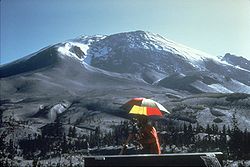- Lava dome
-
In volcanology, a lava dome is a roughly circular mound-shaped protrusion resulting from the slow extrusion of viscous lava from a volcano. The geochemistry of lava domes can vary from basalt to rhyolite although most preserved domes tend to have high silica content.[1] The characteristic dome shape is attributed to high viscosity that prevents the lava from flowing very far. This high viscosity can be obtained in two ways: by high levels of silica in the magma, or by degassing of fluid magma. Since viscous basaltic and andesitic domes weather fast and easily break apart by further input of fluid lava, most of the preserved domes have high silica content and consists of rhyolite or dacite.
Contents
Dome dynamics
Lava domes are dynamic structures that evolve over time undergoing various processes such as growth, collapse, solidification and erosion.
Lava domes grow by endogenic dome growth or exogenic dome growth. The first one implies dome interior expansion to accommodate new lava and the second one refers to superficial piling up of lava.[1] It is the high viscosity of the lava that prevents it from flowing far from the vent from which it extrudes, creating a dome-like shape of sticky lava that then cools slowly in situ. Domes may reach heights of several hundred meters, and can grow slowly and steadily for months (e.g. Unzen volcano), years (e.g. Soufrière Hills volcano), or even centuries (e.g. Mount Merapi volcano). The sides of these structures are composed of unstable rock debris. Due to the intermittent build up of gas pressure, erupting domes can often experience episodes of explosive eruption over time. If part of a lava dome collapses while it is still molten, it can produce pyroclastic flows,[citation needed] one of the most lethal forms of volcanic event. Other hazards associated with lava domes are the destruction of property, forest fires, and lahars triggered by pyroclastic flows near mud, snow and ice. Lava domes are one of the principal structural features of many stratovolcanoes worldwide. Lava domes cause explosions to become more dangerous since they contain rhyolitic silica rich lava.
Characteristics of lava dome eruptions include shallow, long-period and hybrid seismicity, which is attributed to excess fluid pressures in the contributing vent chamber. Other characteristics of lava domes include their hemispherical dome shape, cycles of dome growth over long periods, and sudden onsets of violent explosive activity.[2] The average rate of dome growth may be used as a rough indicator of magma supply, but it shows no systematic relationship to the timing or characteristics of lava dome explosions.[3]
Related landforms
Cryptodomes
A cryptodome (from Greek κρυπτός, kryptos, "hidden, secret") is a dome-shaped structure created by accumulation of viscous magma at a shallow depth. One example of a cryptodome was in the May 1980 eruption of Mount St. Helens, where the explosive eruption began after a landslide caused the side of the volcano to fall, leading to explosive decompression of the subterranean cryptodome.
Lava coulees
Coulees are lava domes that have experienced some flow away from their original position, thus resembling both lava domes and lava flows.[1]
Examples of lava domes
Main article: List of lava domesLava domes Dome or volcano name Country Volcanic area Composition Last dome eruption
or growth episodeChaitén Chile Southern Volcanic Zone Rhyolite 2009 Cordón Caulle Chile Southern Volcanic Zone Rhyodacite to Rhyolite Holocene Galeras Colombia Northern Volcanic Zone Katla Iceland Iceland Hotspot Rhyolite 1999 onwards [4] Lassen Peak California, USA Cascade Volcanic Arc Basalt 1917 Mount Meager British Columbia, Canada Cascade Volcanic Arc Dacite 2350 BP Mount Merapi Indonesia Sunda Arc Nea Kameni Greece Volcán Nuevo Chile Southern Volcanic Zone Dacite 1986 Puy-de-Dôme France Chaîne des Puys ca. 5760 BC Santiaguito Guatemala Central America Volcanic Arc Dacite 2009 Sollipulli Chile Southern Volcanic Zone Andesite to Dacite Soufrière Hills Montserrat Lesser Antilles 2009 Mount St. Helens Washington, USA Cascade Volcanic Arc Basalt 2008 Torfajökull Iceland Iceland Hotspot Rhyolite Unnamed Japan Japan Arc Dacite Miocene[5] Wizard Island Oregon, USA Cascade Volcanic Arc Basalt 2850 BC References
- ^ a b c Fink, Jonathan H., Anderson, Steven W. (2001), Sigursson, Haraldur, ed., Bernard Lewis, Academic Press, pp. 307–319.
- ^ Sparks, R.S.J. (1997)
- ^ Newhall, C.G., W.G. Melson (1983)
- ^ http://volcanism.wordpress.com/2010/03/04/eyjafjallajokull-and-katla-restless-neighbours/
- ^ Yoshihiko Goto and Nobutaka Tsuchiya. Morphology and growth style of a Miocene submarine dacite lava dome at Atsumi, northeast Japan. 2004 Elsevier B.V.
- Global Volcanism Program: Lava Domes
- USGS Photo glossary of volcano terms: Lava dome
- Sparks, R.S.J. (August 1997), "Causes and consequences of pressurisation in lava dome eruptions", Earth and Planetary Science Letters 150 (3–4): 177–189, Bibcode 1997E&PSL.150..177S, doi:10.1016/S0012-821X(97)00109-X, http://www.sciencedirect.com/science?_ob=ArticleURL&_udi=B6V61-4177RWJ-1&_user=778111&_coverDate=08%2F31%2F1997&_rdoc=1&_fmt=&_orig=search&_sort=d&view=c&_acct=C000043085&_version=1&_urlVersion=0&_userid=778111&md5=c0def50303a799fcb146e880c79fb89d
- Newhall, C.G.; Melson., W.G. (September 1983), "Explosive activity associated with the growth of volcanic domes", Journal of Volcanology and Geothermal Research 17 (1–4): 111–131, doi:10.1016/0377-0273(83)90064-1, http://www.sciencedirect.com/science?_ob=ArticleURL&_udi=B6VCS-48B0RF7-2W&_user=778111&_coverDate=09%2F30%2F1983&_fmt=abstract&_orig=search&_cdi=5962&view=c&_acct=C000043085&_version=1&_urlVersion=0&_userid=778111&md5=8da52641a1e571b220630bba6cf622f3&ref=full
External links
 Media related to Lava domes at Wikimedia CommonsCategories:
Media related to Lava domes at Wikimedia CommonsCategories:- Lava domes
- Volcanic landforms
Wikimedia Foundation. 2010.




